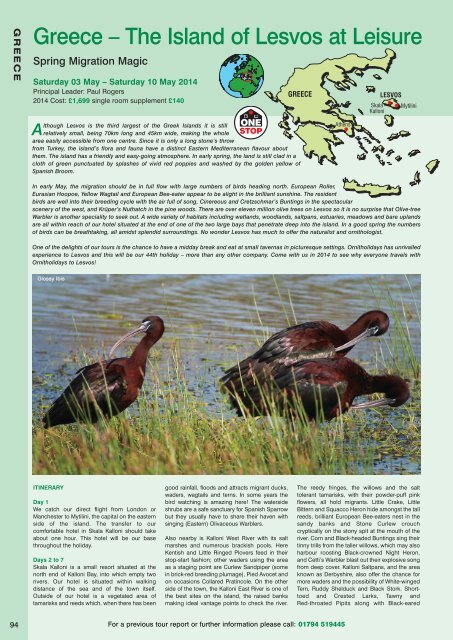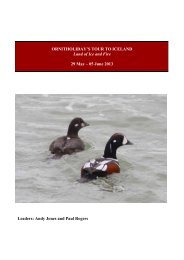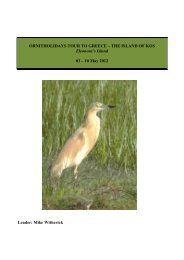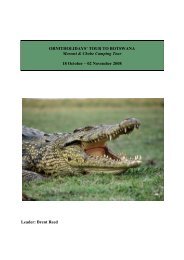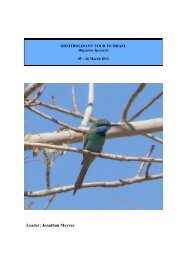Download 2014 Brochure (.pdf) - Ornitholidays
Download 2014 Brochure (.pdf) - Ornitholidays
Download 2014 Brochure (.pdf) - Ornitholidays
Create successful ePaper yourself
Turn your PDF publications into a flip-book with our unique Google optimized e-Paper software.
G R E E C E<br />
Greece – The Island of Lesvos at Leisure<br />
Spring Migration Magic<br />
Saturday 03 May – Saturday 10 May <strong>2014</strong><br />
Principal Leader: Paul Rogers<br />
<strong>2014</strong> Cost: £1,699 single room supplement £140<br />
GREECE<br />
Although Lesvos is the third largest of the Greek Islands it is still<br />
relatively small, being 70km long and 45km wide, making the whole<br />
area easily accessible from one centre. Since it is only a long stone’s throw<br />
from Turkey, the island’s flora and fauna have a distinct Eastern Mediterranean flavour about<br />
them. The island has a friendly and easy-going atmosphere. In early spring, the land is still clad in a<br />
cloth of green punctuated by splashes of vivid red poppies and washed by the golden yellow of<br />
Spanish Broom.<br />
Athens<br />
Skala<br />
Kalloni<br />
LESVOS<br />
Mytilini<br />
In early May, the migration should be in full flow with large numbers of birds heading north. European Roller,<br />
Eurasian Hoopoe, Yellow Wagtail and European Bee-eater appear to be alight in the brilliant sunshine. The resident<br />
birds are well into their breeding cycle with the air full of song, Cinereous and Cretzschmar’s Buntings in the spectacular<br />
scenery of the west, and Krüper’s Nuthatch in the pine woods. There are over eleven million olive trees on Lesvos so it is no surprise that Olive-tree<br />
Warbler is another speciality to seek out. A wide variety of habitats including wetlands, woodlands, saltpans, estuaries, meadows and bare uplands<br />
are all within reach of our hotel situated at the end of one of the two large bays that penetrate deep into the island. In a good spring the numbers<br />
of birds can be breathtaking, all amidst splendid surroundings. No wonder Lesvos has much to offer the naturalist and ornithologist.<br />
One of the delights of our tours is the chance to have a midday break and eat at small tavernas in picturesque settings. <strong>Ornitholidays</strong> has unrivalled<br />
experience to Lesvos and this will be our 44th holiday – more than any other company. Come with us in <strong>2014</strong> to see why everyone travels with<br />
<strong>Ornitholidays</strong> to Lesvos!<br />
Glossy Ibis<br />
ITINERARY<br />
Day 1<br />
We catch our direct flight from London or<br />
Manchester to Mytilini, the capital on the eastern<br />
side of the island. The transfer to our<br />
comfortable hotel in Skala Kalloni should take<br />
about one hour. This hotel will be our base<br />
throughout the holiday.<br />
Days 2 to 7<br />
Skala Kalloni is a small resort situated at the<br />
north end of Kalloni Bay, into which empty two<br />
rivers. Our hotel is situated within walking<br />
distance of the sea and of the town itself.<br />
Outside of our hotel is a vegetated area of<br />
tamarisks and reeds which, when there has been<br />
good rainfall, floods and attracts migrant ducks,<br />
waders, wagtails and terns. In some years the<br />
bird watching is amazing here! The waterside<br />
shrubs are a safe sanctuary for Spanish Sparrow<br />
but they usually have to share their haven with<br />
singing (Eastern) Olivaceous Warblers.<br />
Also nearby is Kalloni West River with its salt<br />
marshes and numerous brackish pools. Here<br />
Kentish and Little Ringed Plovers feed in their<br />
stop-start fashion; other waders using the area<br />
as a staging point are Curlew Sandpiper (some<br />
in brick-red breeding plumage), Pied Avocet and<br />
on occasions Collared Pratincole. On the other<br />
side of the town, the Kalloni East River is one of<br />
the best sites on the island, the raised banks<br />
making ideal vantage points to check the river.<br />
The reedy fringes, the willows and the salt<br />
tolerant tamarisks, with their powder-puff pink<br />
flowers, all hold migrants. Little Crake, Little<br />
Bittern and Squacco Heron hide amongst the tall<br />
reeds, brilliant European Bee-eaters nest in the<br />
sandy banks and Stone Curlew crouch<br />
cryptically on the stony spit at the mouth of the<br />
river. Corn and Black-headed Buntings sing their<br />
tinny trills from the taller willows, which may also<br />
harbour roosting Black-crowned Night Heron,<br />
and Cetti’s Warbler blast out their explosive song<br />
from deep cover. Kalloni Saltpans, and the area<br />
known as Derbyshire, also offer the chance for<br />
more waders and the possibility of White-winged<br />
Tern, Ruddy Shelduck and Black Stork. Shorttoed<br />
and Crested Larks, Tawny and<br />
Red-throated Pipits along with Black-eared<br />
94<br />
For a previous tour report or further information please call: 01794 519445


